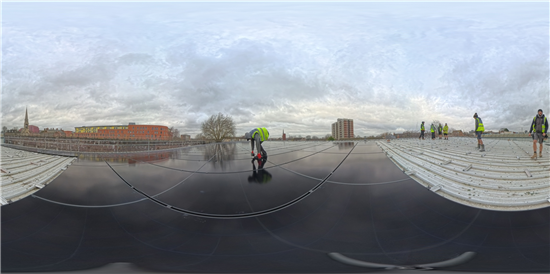Green aims and achievements
Gloucestershire Archives' Green Pledge Project, funded by the National Lottery Heritage Fund, takes a holistic ‘green’ approach aiming to reduce our environmental footprint, catalogue environmental archives, train an archives apprentice, co-create green themed activities and exhibitions, provide volunteer opportunities and run a public pledge campaign.
We recently created a green action plan in just over an hour covering procurement, transport, building, community garden, collections, digital, training and waste. So far we’ve catalogued over 9000 plans relating to rivers and flooding (helping reduce our cataloguing backlog). We’re planning a flooding workshop for researchers and those planning preventative measures, whilst digital copies of some orchard records have been sent to those working with endangered species in Kent. We’re hoping our weather records will be used by meteorologists working on climate change models.


We’re working with AMPS to continue driving down our gas and electricity usage across the site and installing solar panels for our roof. We’re grateful to GCC’s Climate Emergency Advisory Group and the sustainability team and for expertise and inspiration. Thanks to the sustainability team, Archives staff, Hub partners and volunteers took part in September’s ‘Love to Ride’ campaign encouraging cycling. Surprisingly, we came first in Gloucestershire and 11th in the UK for our category.
By taking this action we’re playing our part in culture change and contributing to GCC’s commitment in 2019 to achieve net zero by 2030.
Cataloguing our environmental heritage
As well as offering a range of interactive events, producing thought-provoking podcasts, and inviting the local community to make use of our fantastic Heritage Hub garden, the Green Pledge Project is also striving away behind the scenes to make more Gloucestershire Archives environmental records accessible to the public.
 Since the project started our Green Pledge Project archivist, Jenny Rutland has been focusing on making the maps and plans deposited by the Environment Agency searchable for the first time. At the time of writing, D7768 looks like an unassuming little collection, but in reality there are over 9000 individual maps and plans, which were originally stored in inaccessible hanging cabinets in a largely random order.
Since the project started our Green Pledge Project archivist, Jenny Rutland has been focusing on making the maps and plans deposited by the Environment Agency searchable for the first time. At the time of writing, D7768 looks like an unassuming little collection, but in reality there are over 9000 individual maps and plans, which were originally stored in inaccessible hanging cabinets in a largely random order.
We are delighted to now be entering the final stages of cataloguing this collection, thanks to our Green Pledge Project archivist and a team of helpful volunteers. Originally drawn by their predecessors, the maps and plans share detailed information about the rivers and brooks that fall under the Environment Agency’s jurisdiction.
Plans showing the location of watercourses, cross sections, and longitudinal sections feature heavily in the collection, helping researchers to understand the size and depth of the rivers.
Flooding is understandably a common theme, with maps giving the extent of flooding (including many documenting the March 1947 floods), hydrographs showing the volume of water passing through gauge points, and many plans showing measures taken to prevent and minimize the impact of flooding on local communities.


Some maps amalgamate erosion over time, showing where land has been lost to the river, and some are annotated with the names and addresses of landowners, offering an interesting opportunity for family history research. This plan of Hope Pill Rhyne in Arlingham shows existing hedges, trees, and plants to be protected, and even identifies badger setts to avoid.

Over the following months all 9000 maps and plans will be regrouped and added to the catalogue, so watch this space as we will let you know as soon as they are ready to view in our searchroom.
Green Pledge Project update
The Green Pledge Project is now into its second year. We’ve started the new year with lots of exciting new events, exhibitions and podcasts in the pipeline.
The Green Pledge exhibition is ready to tour venues across our area. The eight pull up panels display a rich mosaic of stories about the environmental heritage in our area, including global warming, changing landscapes and lifestyles, species loss and campaigning.


On Saturday 11th January the Green Pledge Open Archives event explored flooding. There were brilliant speakers as well as an exhibition in the foyer of the work of Ebb and Flow, a collection of artists who are campaigning about pollution in the River Wye. You can see the exhibition until the beginning of February.
Over the coming months we will be working with several artists including Natasha Housego, who is sculpting a piece of ash into a ‘Pledge Hog’. This will be the receptacle for people to make their pledges for the environment. Natasha has been working in freezing temperatures in the garden at Nature in Art at Twigworth. She’ll also be at Stroud Museum in the Park and Folk of Gloucester, so if you wish to see her, pop along, have a look at hedgehog related documents and drop a pledge into the pot. Find out more here
The Green Pledge Learning and Outreach Team also attended a wassail at the Folk Museum, taking with them documents about the tradition, the fascinating orchard book and correspondence between apple growers from the 1800s.
Our podcast series with people who work for nature and the environment continues, with new episodes from George Peterken about the grasslands and his work as a specialist woodland ecologist, and Mollie Meager talking about her life as a environmental campaigner.
There are lots of opportunities to volunteer with the project and you can catch up with us at Stroud Museum in the Park in half term.
To find out more please sign up for updates on our webpage